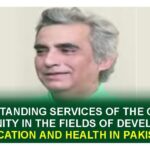Who Killed UN Secretary-General Daag Hammarskjold and Why?
Introduction :
The death of Secretary General of the United Nations Dag Hammarskjold still haunts the annals of history and remains an intractable and unsolved mystery that has fascinated the world for more than six decades. On the fateful night of September 17, 1961, the world lost one of its most visionary and principled leaders when Hammarskjold’s plane crashed near Ndola, Northern Rhodesia, during an important peacekeeping mission at the heart of the Congo crisis. Since that tragic day, many investigations, inquiries, and commissions have tried to unravel the mystery behind the crash and shed light on the circumstances that led to his death. However, each inquiry seems to have raised more questions than answers, leaving behind speculation, conjecture, and lingering doubts. Dag Hammarskjold was not just another statesman; he embodied the spirit of international cooperation and dedicated his life to the pursuit of peace and the promotion of human rights. As Secretary-General of the United Nations, he navigated the treacherous waters of post-World War II geopolitics, fervently advocating decolonization, diplomacy, and peaceful conflict resolution. His diplomacy and unwavering commitment to the principles of the United Nations Charter have earned him the respect and admiration of leaders and citizens around the world. The circumstances of his death only added to the intrigue surrounding the life of Hammarskjold. The official investigation by the Rhodesian authorities was riddled with accusations of incompetence, political interference, and questionable manipulation of evidence. Critics argued that local authorities, led by Prime Minister Ian Smith, had reason to block a thorough and impartial investigation. Therefore, the veracity of the official report has been questioned, leaving room for countless theories and speculations. The purpose of this blog post is to explore the various theories surrounding the death of Dag Hammarskjold and consider the possible motives and interests that may have caused the tragic events of that fateful night. From the possibility of plane sabotage to assassination plots to Cold War politics, we analyze each theory and examine the evidence to support or disprove them. In addition, we explore the complex international implications of Hammarskjold’s death and its impact on the United Nations and global diplomacy. His death has left a void on the international scene, raising concerns about the safety of diplomats and leaders who work tirelessly to mediate conflicts and promote peace.
Dag Hammarskjold and his role in the United Nations
Dag Hammarskjold’s journey as UN Secretary-General was marked by a brilliant career in diplomacy and public administration. Born into a prominent Swedish family, Hammarskjold showed exceptional academic prowess, earning degrees in law, economics, and literature. He entered the Swedish civil service in the 1930s and quickly gained a reputation as a skilled negotiator and diplomat. Hammarskjold held several key positions in the Swedish government during his diplomatic career, demonstrating his commitment to promoting international peace and cooperation. His commitment to multilateralism and understanding of complex global issues attracted the attention of the international community, leading to his appointment as Secretary General of the United Nations in April 1953. As Secretary General, Hammarskjold faced several challenges, including the Suez Crisis of 1956, where he played a decisive role in brokering a peace treaty between Egypt and Israel. His diplomatic skills and unwavering commitment to the principles of the United Nations Charter have earned him widespread respect and admiration. II. The disputed circumstances of Hammarskjold’s death
On the night of September 17, 1961, Hammarskjold began a mission to negotiate a ceasefire between UN forces and Katangan separatists in the Congo (now the Democratic Republic of the Congo). His flight, a DC-6 commissioned by the United Nations, crashed near Ndola shortly before midnight. All passengers on board died in the accident, including Hammarskjold. The investigation of the crash site by the Rhodesian authorities was under intense scrutiny. Witnesses’ reports of weather conditions and other aircraft in the vicinity were conflicting, casting doubt on the veracity of the official report. In addition, the failure of Rhodesian authorities to quickly secure the crash site and the possible tampering of evidence fueled speculation of a cover-up.
I. The disputed circumstances of Hammarskjold’s death
On the night of September 17, 1961, Hammarskjold began a mission to negotiate a ceasefire between UN forces and Katangan separatists in the Congo (now the Democratic Republic of the Congo). His flight, a DC-6 commissioned by the United Nations, crashed near Ndola shortly before midnight. All passengers on board died in the accident, including Hammarskjold.
The investigation of the crash site by the Rhodesian authorities was under intense scrutiny. Witnesses’ reports of weather conditions and other aircraft in the vicinity were conflicting, casting doubt on the veracity of the official report. In addition, the failure of Rhodesian authorities to quickly secure the crash site and the possible tampering of evidence fueled speculation of a cover-up.
II. Official investigation
The preliminary investigation by the Rhodesian authorities has been criticized for a lack of transparency and possible political interference. Many believed that the Rhodesian government, led by Prime Minister Ian Smith, had reason to block a full investigation. The Congo crisis was at its peak at the time, and Hammarskjold’s efforts to promote peace and self-determination in the region threatened the interests of powerful actors.
The United Nations also established an inquiry known as the Goldstone Commission to look into the accident. However, a commission report published in 1962 did not definitively determine the cause of the accident, so the circumstances surrounding Hammarskjold’s death raised doubts.
III. Theories about who killed Hammarskjold
A. Aircraft sabotage
One popular theory suggests that the plane carrying Hammarskjold was sabotaged, causing the fatal crash. Proponents of this theory point to the possibility that the plane was modified before takeoff to ensure its tragic end.
Possible motives for sabotaging the escape include opposition to Hammarskjold’s mediation efforts in the Congo crisis, fear of revealing a hidden agenda or sensitive information, or a desire to prevent political developments that might have challenged powerful interests.
B. Assassination Plot
Another widely debated theory proposes that Dag Hammarskjold was the target of a deliberate assassination plot. According to this theory, powerful actors, whether state-sponsored or non-state entities, sought to eliminate the Secretary General due to his principled stand on various issues.
Hammarskjold’s insistence on impartiality and dedication to international law could have made him a perceived threat to various actors who sought to maintain the status quo or further their hidden agendas.
C. Cold War Politics
The 1960s were dominated by the geopolitical tensions of the Cold War, with powerful nations engaged in covert operations and intelligence activities worldwide. Hammarskjold’s neutral stance during the Congo Crisis may have clashed with the interests of major powers, leading to his perceived vulnerability.
Some theories propose the involvement of foreign intelligence agencies acting on behalf of specific countries, driven by a desire to assert dominance or control over strategic resources and geopolitical influence in the region.
D. Mining Interests and the Congo Crisis
The Congo Crisis was not solely a political conflict; it was also intertwined with economic interests and the exploitation of the Congo’s vast mineral wealth. Multinational corporations had a significant stake in the region’s resources, and Hammarskjold’s efforts to promote self-determination and prevent resource exploitation may have threatened their economic ambitions.
This theory explores the possibility that powerful corporations or their proxies had a hand in Hammarskjold’s death to protect their economic interests in the region.
IV. Legacy and Ongoing Investigations
Dag Hammarskjold’s death left an indelible mark on the United Nations and the international community. His principled leadership and dedication to peace continue to inspire those who strive for justice and accountability in global affairs. In recent years, efforts to investigate the circumstances of Hammarskjold’s death have experienced renewed momentum. In 2012, a panel of experts known as the Hammarskjold Commission was established to reexamine the evidence. The commission concluded that there was “significant new evidence” pointing to the possibility of an external attack on the aircraft.
In 2015, the United Nations established an Independent Expert Panel to conduct further investigations. The panel’s report, released in 2017, emphasized the need for cooperation from member states to uncover the truth fully.
V. Cover-ups and Political Interference
Over the years, allegations of cover-ups and political interference have dogged the investigation into Hammarskjold’s death. Many believe that some governments and powerful entities may have actively worked to suppress information or manipulate the official narrative to protect their interests.
The Rhodesian authorities’ handling of the initial investigation has been a major point of contention. Critics argue that their close ties to South Africa and the Katangese secessionist regime influenced the conduct and outcome of the inquiry, potentially obscuring critical evidence.
VI. Witnesses and Testimonies
Numerous witnesses have come forward over the years, providing testimonies that challenge the official version of events surrounding the plane crash. Some witnesses claim to have seen or heard explosions before the crash, suggesting the possibility of foul play.
However, locating and verifying the credibility of witnesses, especially decades after the event, presents significant challenges for investigators seeking to piece together a comprehensive and accurate account of what transpired that night.
VII. The Role of Western Powers:
The involvement of Western powers, particularly Britain and the United States, in Dag Hammarskjold’s death, remains a controversial and speculative aspect of the investigation. Although direct evidence does not implicate these nations in the assassination, historical context, geopolitical interests, and covert operations during the Cold War fueled suspicions and led to various theories about their possible role.
The Geopolitical Context of the Cold War:
In the 1960s, the world was deeply entrenched in the geopolitical tensions of the Cold War. The United States and the Soviet Union were engaged in a global struggle for influence and dominance, and Africa became a major battleground of ideological competition. The Congo crisis was one such arena where Western and Soviet interests collided, as both sides sought to gain influence over the newly independent African states. Dag Hammarskjold’s commitment to maintaining the neutrality and impartiality of the UN during the Congo crisis challenged some Western countries. His efforts to mediate the conflict and advocate for decolonization collided with the interests of those seeking to control the strategic resources and geopolitical influence of the region. IX.
Opposition to Hammarskjold’s initiatives:
Hammarskjold’s commitment to promoting self-determination and peace in the Congo often put him in conflict with powerful interests seeking to protect their own economic and political interests. In particular, the mining industry made a significant economic contribution to the region, and Hammarskjold’s efforts to control the use of natural resources and ensure fair practices could be perceived as a threat to the profits of Western companies.
In addition, his role in supporting the independence and sovereignty of African countries was generally not appreciated by all Western countries. Some critics in those states saw his efforts as a threat to their influence and control over African governments, causing tension between Hammarskjold and certain Western governments.
Covert operations and intelligence:
During the Cold War, covert operations and intelligence were common tools used by states to advance their interests and combat perceived threats. The possibility of covert operations, including assassination plots, cannot be ruled out due to the secrecy surrounding such operations.
Although no direct evidence points to a specific conspiracy or involvement of Western countries, the secretive nature of such activities makes it difficult to fully determine their role in Hammarskjold’s death. In later years, declassified documents revealed covert intelligence operations during the period, prompting speculation about their possible involvement. Challenges to discover the truth:
The passage of time, the destruction or concealment of relevant documents, and the reluctance of some governments to fully cooperate with the investigation have all presented significant challenges to discovering the truth behind Hammarskjold’s death. Decades after the incident, finding and verifying credible witnesses and evidence has been an arduous task for investigators.
International Impact and the Pursuit of Truth:
Dag Hammarskjold’s death sent shockwaves through international society and deeply affected the UN and the field of international diplomacy. As a visionary leader, Hammarskjold influenced the design of UN peacekeeping operations and conflict resolution through diplomacy. His untimely death not only robbed the world of a principled diplomat but also raised concerns about the safety and security of high-level diplomats and leaders involved in sensitive peacekeeping missions and negotiations.
Implications for the United Nations:
The death of Dag Hammarskjold left a significant vacuum in the leadership of the United Nations. His diplomatic skills, commitment to peace, and impartiality were widely admired and earned him respect even among those who disagreed with some UN initiatives. The loss of such a respected and competent Secretary-General was deeply felt in the organization, his colleagues and subordinates mourned the departure of the leader of international diplomacy.
Hammarskjold’s commitment to the principles of the UN Charter endeared him to member states and won their trust. His death created a leadership vacuum that was difficult to fill, and the UN struggled to find a successor for his diplomatic skills and integrity.
Questions about diplomatic immunity and the security of diplomats:
Hammarskjold’s death raised questions about the safety and security of diplomats, especially those involved in conflict mediation and peacekeeping missions. Diplomats, including the Secretary-General, must enjoy diplomatic immunity, which ensures that they can carry out their duties without fear of harassment, arrest, or harm. However, Hammarskjold’s tragic fate highlighted the vulnerability of diplomats working in conflict zones or regions with unstable political situations. It highlighted the risks they faced in trying to resolve conflicts and promote peace, and often put themselves in harm’s way to achieve those noble goals.
The Pursuit of Truth and Justice:
The unexplained mystery surrounding Hammarskjold’s death has sparked a relentless search for truth and justice by various individuals, groups, and organizations around the world. An inconclusive official investigation by the Rhodesian authorities and allegations of a cover-up and political interference led to criminal charges.
Over the years, a number of independent initiatives and investigations have been conducted to re-examine the evidence and explain what really happened on that fateful night. In 2012, the Hammarskjold Commission of independent experts was established to re-examine the subject. The commission’s findings revealed “significant new evidence” that suggested an outside attack on the plane was plausible. Later, in 2015, the UN established an independent panel of experts to conduct further investigations.
The search for truth in the Hammarskjold case reflects a broader commitment to accountability and transparency in international relations. It is a reminder that the international community must not rest until those responsible for violence against diplomats and peacekeepers are brought to justice. Adherence to UN principles:
Solving the mystery of Hammarskjold’s death is necessary not only to honor his memory and legacy but also to uphold the founding principles of the United Nations. The UN Charter emphasizes the peaceful resolution of conflicts, respect for human rights, and the promotion of international cooperation. The search for truth, in this case, reflects a commitment to maintain the integrity of the organization and ensure that violence is not overlooked.
New Evidence: Linking an RAF Veteran to Dag Hammarskjold’s Death
According to The Guardian article published on January 12, 2019, Jan van Risseghem, a former pilot in the Royal Air Force, allegedly confessed to being involved in the attack that led to the tragic demise of Dag Hammarskjold. This confession reportedly came to light after van Risseghem’s death in 2016 when he disclosed his purported role to friends.
The emergence of this new evidence has reignited interest in the case and raised hope that the truth about what truly happened on that fateful night in 1961 may finally come to light. However, it is essential to approach such claims with caution and subject them to a rigorous investigation to determine their credibility and authenticity.
As the pursuit of truth and justice continues, it becomes more imperative than ever for relevant authorities and investigative bodies to thoroughly examine the evidence, corroborate the claims, and seek additional information to provide a comprehensive understanding of the events surrounding Hammarskjold’s death.
The world will be closely watching as the investigation progresses, hoping that it will finally bring closure to the enduring mystery surrounding the death of the esteemed United Nations Secretary-General.
Conclusion
The death of Dag Hammarskjold remains an unsolved mystery that gripped the world for more than six decades. Despite many investigations and inquiries, the truth behind his tragic death eludes us. Dag Hammarskjold’s legacy as a visionary leader and activist for peace lives on, inspiring diplomats and peacemakers to defend the principles of the United Nations.
The impact of his death on the United Nations and international diplomacy cannot be overstated. In this case, the search for truth and justice is essential to maintain the integrity of the organization and honor the sacrifices made for global peace. As we continue to investigate the complex web of Cold War geopolitical interests and covert operations, we must remain steadfast in our commitment to uncovering the truth. Solving this puzzle is not just an academic endeavor; To preserve the ideals of Dag Hammarskjold is a deep responsibility.
In the search for the truth, we honor the memory of a remarkable leader and strengthen our commitment to justice and responsibility in international relations. Although the answers may still be elusive, the search for truth is still necessary to ensure that the sacrifices of diplomats and peacekeepers are never forgotten and that their noble efforts inspire future generations to work for a better and more harmonious world for all.






